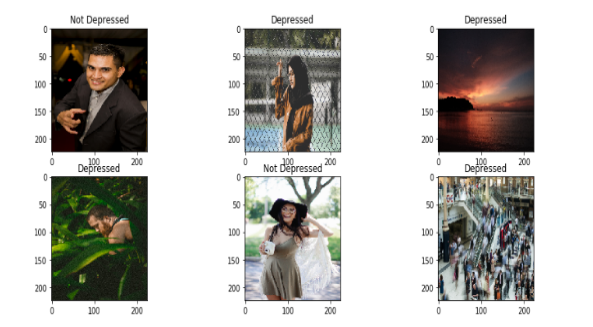This project aims to detect early indicators of depression by analyzing data from a range of social media platforms, including images and texts.
Table of Contents
Data collection ↑
Data were collected from Pexels, Unsplash and Twitter .
Pexels and Unsplash are two freely-usable images platforms.
Tweets used are publicly available.
Visual Data:
The overall process of scraping images from unsplash and pexels is presented as follows:
Images were crawled from Pexels using Selenium and from Unsplash using UnsplashAPI.
- 6250 images labeled as "Depressed"
- 5234 images labeled as "Not Depressed"
This is a sample of the dataset:
Images can be loaded as shown in Project Cheat Sheet and codes are available here .
Textual Data:
Hashtags that were used are trending hashtags using Keywords inspired from DSM-5(Diagnostic and Statistical Manual of Mental Disorders).
Textual data were collected from Twitter users sharing their posts publicly using twint.
Overall, 5460 tweets were collected.
The process was:
You can check the result of texts loader in Project Cheat Sheet and codes are available here . This is a sample of the dataset:
Models ↑
Models for Images:
Trained five different types of models:
- Deep CNN
- ResNet50
- BiT-L(ResNet50x1)
- BiT-L(ResNet50x3)
- BiT-L(ResNet101x1): This was the best model in term of Accuracy(0.82), Precisions, Recalls, and F1-scores with hyperparameters as follow SGD (Stochastic gradient descent) as optimizer, 50 epochs, leraning rate is variable and size of images is 128*128p
Models for Texts:
Trained two different types of models:
- LSTM
- GloVe+BiLSTM: This was the best model in term of Accuracy(0.7), Precisions, Recalls, and F1-scores.
For the best models I actually chose, you can find three notebooks:
- For images: this notebook presents the test of BiT-L(ResNet101x1) model which is the best model for classifying images.
- For Texts: this notebook presents the test of GloVe+BiLSTM which is the best model for classifying texts.
- For integrating models: this notebook is to test the integration of BiT-L(ResNet101x1) and GloVe+BiLSTM to get a multimodal model.
You can find the saved weights for images best model and texts best model here.
Software and technologies: ↑
- Python (version 3.8.3)
- Anaconda (Distribution 2020.02)
- TensorFlow
- Keras
- Jupyter Notebook
- Pycharm (Community Edition)
Hardware ↑
In the process of the implementation of our solution we used two main machines, a local machine for refactoring codes, testing models and research, and a virtual machine (VM) on Google Cloud Platform (GCP) to run models and codes that are heavy in term of computation and time. Following are the specifications of these machines:
- Local Machine: Lenovo E330:
- Operating System : Kali Linux 2020.2
- CPU: Intel Core i5-3230M 2,6GHz
- RAM: 8 Go DDR3
- Disk: 320 GB HDD
- Virtual Machine on GCP: mastermind
I used two configurations:- For tasks that are not heavy in both computation and time:
- Operating System : Ubuntu 19.10
- Machine Type: n1-highmem-8
- CPU: 8 vCPUs
- RAM: 16 Go
- Disk: 100 GB SSD
-
For training models:
- Operating System : Ubuntu 19.10
- Machine Type: n1-highmem-8
- CPU: 8 vCPUs
- RAM: 52 Go
- Disk: 100 GB SSD
Finally, I hope you enjoyed my work and got inspired to help people get noticed 🧐. If you want more details you can find my report here .
Please contact me for more details, I would be really happy to share more infos 😋.
- For tasks that are not heavy in both computation and time:

